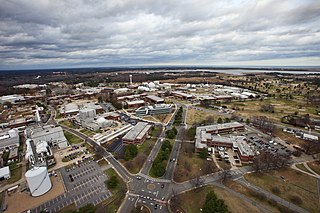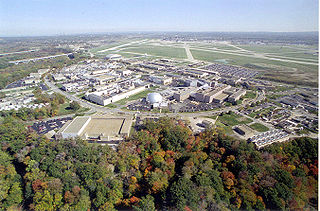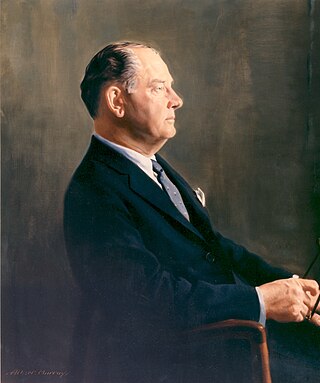
The Ames Research Center (ARC), also known as NASA Ames, is a major NASA research center at Moffett Federal Airfield in California's Silicon Valley. It was founded in 1939 as the second National Advisory Committee for Aeronautics (NACA) laboratory. That agency was dissolved and its assets and personnel transferred to the newly created National Aeronautics and Space Administration (NASA) on October 1, 1958. NASA Ames is named in honor of Joseph Sweetman Ames, a physicist and one of the founding members of NACA. At last estimate NASA Ames had over US$3 billion in capital equipment, 2,300 research personnel and a US$860 million annual budget.

Moffett Federal Airfield, also known as Moffett Field, is a joint civil-military airport located in an unincorporated part of Santa Clara County, California, United States, between northern Mountain View and northern Sunnyvale. On November 10, 2014, NASA announced that it would be leasing 1,000 acres (400 ha) of the airfield property to Google for 60 years.

The National Advisory Committee for Aeronautics (NACA) was a United States federal agency founded on March 3, 1915, to undertake, promote, and institutionalize aeronautical research. On October 1, 1958, the agency was dissolved and its assets and personnel were transferred to the newly created National Aeronautics and Space Administration (NASA). NACA is an initialism, i.e., pronounced as individual letters, rather than as a whole word.

The Langley Research Center, located in Hampton, Virginia near the Chesapeake Bay front of Langley Air Force Base, is the oldest of NASA's field centers. LaRC has focused primarily on aeronautical research but has also tested space hardware such as the Apollo Lunar Module. In addition, many of the earliest high-profile space missions were planned and designed on-site. Langley was also considered a potential site for NASA's Manned Spacecraft Center prior to the eventual selection of Houston, Texas.

NASA John H. Glenn Research Center at Lewis Field is a NASA center within the cities of Brook Park and Cleveland between Cleveland Hopkins International Airport and the Rocky River Reservation of Cleveland Metroparks, with a subsidiary facility in Sandusky, Ohio. Its director is James A. Kenyon. Glenn Research Center is one of ten major NASA facilities, whose primary mission is to develop science and technology for use in aeronautics and space. As of May 2012, it employed about 1,650 civil servants and 1,850 support contractors on or near its site.
Draper Laboratory is an American non-profit research and development organization, headquartered in Cambridge, Massachusetts; its official name is The Charles Stark Draper Laboratory, Inc. The laboratory specializes in the design, development, and deployment of advanced technology solutions to problems in national security, space exploration, health care and energy.

Thomas Keith Glennan was the first Administrator of the National Aeronautics and Space Administration, serving from August 19, 1958 to January 20, 1961.

Carnegie Mellon Silicon Valley is a degree-granting branch campus of Carnegie Mellon University located in the heart of Silicon Valley in Mountain View, California. It was established in 2002 at the NASA Ames Research Center in Moffett Field.
The Cooper-Harper Handling Qualities Rating Scale (HQRS), sometimes Cooper-Harper Rating Scale (CHRS), is a pilot rating scale, a set of criteria used by test pilots and flight test engineers to evaluate the handling qualities of aircraft while performing a task during a flight test. The scale ranges from 1 to 10, with 1 indicating the best handling characteristics and 10 the worst. The criteria are evaluative and thus the scale is subjective.

The Environmental Research Aircraft and Sensor Technology, or ERAST program was a NASA program to develop cost-effective, slow-flying unmanned aerial vehicles (UAVs) that can perform long-duration science missions at altitudes above 60,000 ft (18,000 m). The project included a number of technology development programs conducted by the joint NASA-industry ERAST Alliance. The project was formally terminated in 2003.

Miriam Rodón Naveira is an environmental scientist from San Juan, Puerto Rico, working at the federal government of the United States for which she was awarded a Silver Medal for Superior Service and a Suzanne Olive EEO and Diversity Award both by the EPA. She was also the first Hispanic woman to serve as branch chief of the EPA's National Exposure Research Laboratory (NERL) and later the first Hispanic woman to become deputy director of NERL's Environmental Sciences Division. Working at NASA since 2000, she now oversees research to enhance collaboration within DFRC, as well as with external entities, in support of the integrated use of remote sensing instruments in aerial platforms.

Clarence A. "Sy" Syvertson (1926-2010) was the Center Director of the Ames Research Center of the National Aeronautics and Space Administration, located at Moffett Field, California.

Simon Peter Worden was Director of NASA's Ames Research Center (ARC) at Moffett Field, California, until his retirement on March 31, 2015. Prior to joining NASA, he held several positions in the United States Air Force and was research professor of astronomy at the University of Arizona, Tucson. He is a recognized expert on space issues – both civil and military. Worden has authored or co-authored more than 150 scientific papers in astrophysics, space sciences, and strategic studies. He served as a scientific co-investigator for two NASA space science missions, and received the NASA Outstanding Leadership Medal for the 1994 Clementine mission. He was named the 2009 Federal Laboratory Consortium Laboratory Director of the Year.
Dr. Henry "Harry" McDonald DSc FREng was a Scottish-American aeronautical engineer specializing in Computational Fluid Dynamics and Director of the NASA Ames Research Center in Moffett Field, California from 1996 to 2002.
There are NASA facilities across the United States and around the world. NASA Headquarters in Washington, DC provides overall guidance and political leadership to the agency. There are 10 NASA field centers, which provide leadership for and execution of NASA's work. All other facilities fall under the leadership of at least one of these field centers. Some facilities serve more than one application for historic or administrative reasons. NASA has used or supported various observatories and telescopes, and an example of this is the NASA Infrared Telescope Facility. In 2013 a NASA Office of the Inspector General's (OIG) Report recommended a Base Realignment and Closure Commission (BRAC) style organization to consolidate NASA's little used facilities. The OIG determined at least 33 of NASA's 155 facilities were underutilized.
Intelligent Robotics Group (IRG) is a division of the Ames Research Center at Moffett Federal Airfield in California's Silicon Valley.

G. Scott Hubbard is a physicist who has been engaged in space-related research as well as program, project and executive management for more than 45 years including 20 years with NASA, culminating as director of NASA's Ames Research Center. As of 2012, Hubbard chairs SpaceX Safety Advisory Panel, he previously served as the NASA representative on the Columbia Accident Investigation Board, was NASA's first Mars program director and restructured the Mars program in the wake of mission failures.
In the nation's quest to provide security along its lengthy coastlines, air reconnaissance was put forth by the futuristic Rear Admiral William A. Moffett. Through his efforts, two Naval Air Stations were commissioned in the early 1930s to port the Naval Airships (dirigibles) which he believed capable of meeting this challenge.
As the coalition of Bay Areas counties predicted when it lobbied for the creation of Moffett Federal Airfield in the late 1920s, the base's research program and facilities catalyzed the development of numerous private technology and aerospace corporations, among them Lockheed Martin and the Hiller Aircraft Corporation.
The Aeronautics Research Mission Directorate (ARMD) is one of five mission directorates within NASA, the other four being the Exploration Systems Development Mission Directorate, the Space Operations Mission Directorate, the Science Mission Directorate, and the Space Technology Mission Directorate. The ARMD is responsible for NASA's aeronautical research, which benefits the commercial, military, and general aviation sectors. The current NASA associate administrator heading ARMD is Robert A. Pearce who has held the position since 2019.
"A Review of the New Initiatives at the NASA Ames Research Center: A Summary of a Workshop" Authors: Charles W. Wessner, Editor, Steering Committee for Government-Industry Partnership for the Development of New Technologies, Board on Science, Technology, and Economic Policy, National Research Council
Consolidated Appropriations Resolution, 2003 (Enrolled as Agreed to or Passed by Both House and Senate) ENHANCED-USE LEASE OF REAL PROPERTY DEMONSTRATION











